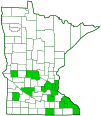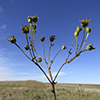prairie dock
(Silphium terebinthinaceum var. terebinthinaceum)
Conservation • Wetland • Description • Habitat • Ecology • Use • Distribution • Taxonomy
Conservation Status |
|
|||||||
| IUCN Red List | not listed |
|||||||
| NatureServe | NNR - Unranked |
|||||||
| Minnesota | not listed |
|||||||
Wetland Indicator Status |
||||||||
| Midwest | FAC - Facultative |
|||||||
| Northcentral & Northeast | FAC - Facultative |
|||||||
Description |
||
Prairie dock, also called prairie rosinweed, is a 40″ to 98″ tall, erect, long-lived, perennial forb that rises on a bassal rosette and usually a single stem from a woody taproot. The taproot may extend up to 12′ deep. The stem is erect, round, hairless, and usually branched. It is sometimes slightly covered with a whitish, waxy coating (glaucous). A basal rosette of large, thick, leathery basal leaves appears early in the season. Later, a single flowering stalk bolts from the center of the rosette and reaches full height in just a few days. Basal leaves are on long leaf stalks and may be triangular, lance-shaped, or egg-shaped. The blades are unlobed, 6″ to 20″ long, and up to 12″ wide. They are usually broadly heart shaped at the base and rounded, angled, or tapered to a point at the tip. The upper surface is hairless and shiny when young, moderately covered with spreading hairs, dull, and rough to the touch when mature. The lower surface is hairy, especially along the midrib. The margins may be coarsely toothed or untoothed. Sometimes there are one or more similar long-stalked leaves attached to the stem near the base. The flowering stems are nearly naked, with usually a few much-reduced, bract-like leaves. Stem leaves are alternate, egg-shaped, stalkless, and ⅜″ to 1¼″ long. They clasp the stem at the base but do not wrap completely around the stem. The margins are untoothed. The inflorescence is an open, branched cluster (panicle) of one to several flower heads at the end of the stem and branches. Each flower head is 2″ to 3½″ wide with disk ½″ to 1½″ wide. There is a whorl of 23 to 33 bracts (involucre) in 2 or 3 overlapping series at the base of the flower head. The involucre is ½″ to 1″ in diameter. The outer bracts are short, broadly elliptic, and tightly appressed. The inner bracts are longer, oblong-elliptic, loose, and usually ascending at the tip. The outer surface is hairless, and sometimes there is a dense fringe of minute hairs along the margin. There are 17 to 29 yellow ray florets and 120 to 140 yellow disk florets. The ray florets are ¾″ to 1¼″ long. The disk florets are sterile. The flower heads are not fragrant. The fruit of the ray floret is a dry cypsela with no fluffy tuft of hairs attached. The cypsela is black, egg-shaped, strongly flattened, winged, ¼″ to ½″ long, and ⅛″ to ⅜″ wide. |
||
Height |
||
40″ to 98″ |
||
Flower Color |
||
Yellow ray florets, yellow disk florets |
||
Similar Species |
||
Habitat |
||
Moderate moisture to wet. Prairies. Full sun. |
||
Ecology |
||
Flowering |
||
July to September |
||
Pests and Diseases |
||
|
||
Use |
||
|
||
Distribution |
||||
|
Sources Prairie dock has not been recorded in the state by the Minnesota DNR or collected by a Minnesota herbarium. Its known range extends no farther west than central Wisconsin and extreme eastern Iowa. In 2015 there were just three records of it in Minnesota. Since then its range appears to be expanding northward. |
|||
| 5/26/2023 | ||||
Nativity |
||||
Native to northeastern, north-central, and southeastern United States, including Iowa and Wisconsin, and to Ontario, Canada. Adventive. |
||||
Occurrence |
||||
Rare in Minnesota. |
||||
Taxonomy |
|||
| Kingdom | Plantae (Plants) | ||
| Division | Tracheophyta (Vascular Plants) | ||
| Subdivision | Spermatophytina (Seed Plants) | ||
| Class | Magnoliopsida (Dicots) | ||
Order |
Asterales (Sunflowers, Bellflowers, Fanflowers, and Allies) | ||
Family |
Asteraceae (Sunflowers, Daisies, Asters, and Allies) | ||
| Subfamily | Asteroideae | ||
| Supertribe | Helianthodae | ||
| Tribe | Heliantheae (Sunflowers and Allies) | ||
| Subtribe | Engelmanniinae | ||
| Genus | Silphium (rosinweeds) | ||
| Species | Silphium terebinthinaceum (prairie dock) | ||
Subordinate Taxa |
|||
|
|||
Synonyms |
|||
Silphium rumicifolium Silphium terebinthinaceum var. luciae-brauniae |
|||
Common Names |
|||
basal-leaf rosinweed basal-leaved rosinweed dock-rosinweed prairie dock prairie-dock prairie rosinweed |
|||
Glossary
Bract
Modified leaf at the base of a flower stalk, flower cluster, or inflorescence.
Clasping
Describing a leaf that wholly or partly surrounds the stem but does not fuse at the base.
Cypsela
A dry, one-chambered, single-seeded fruit, formed from a single carpel, with the seed attached to the membranous outer layer (wall) only by the seed stalk; the wall, formed from the wall of the inferior ovary and also from other tissues derived from the receptacle or hypanthium, does not split open at maturity, but relies on decay or predation to release the contents.
Glaucous
Pale green or bluish gray due to a whitish, powdery or waxy film, as on a plum or a grape.
Panicle
A pyramidal inflorescence with a main stem and branches. Flowers on the lower, longer branches mature earlier than those on the shorter, upper ones.
Wing
A thin, flat, membranous, usually transparent appendage on the margin of a structure.
Visitor Photos |
|||||
Share your photo of this plant. |
|||||
| This button not working for you? Simply email us at info@MinnesotaSeasons.com. Attach one or more photos and, if you like, a caption. |
|||||
Dave Jungst |
|||||
Only a few scattered plants found in the upland on the east end of the SNA in remnant native prairie. One plant was about 7 feet tall. |
|||||
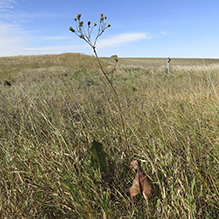 |
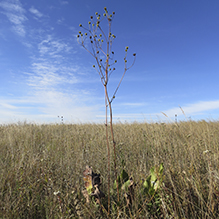 |
||||
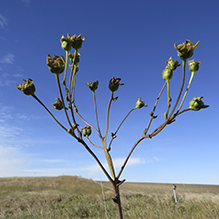 |
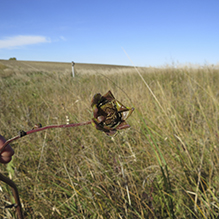 |
||||
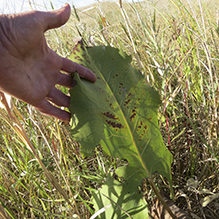 |
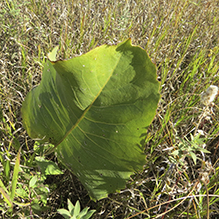 |
||||
MinnesotaSeasons.com Photos |
|||||
Plant |
|||||
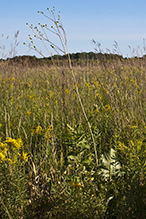 |
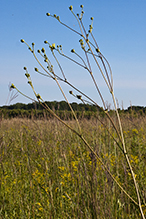 |
||||
Inflorescence |
|||||
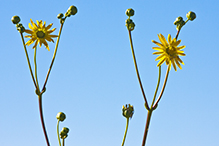 |
|||||
Flower Head |
|||||
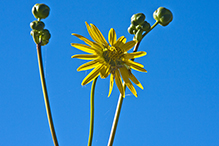 |
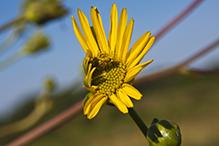 |
||||
Involucre |
|||||
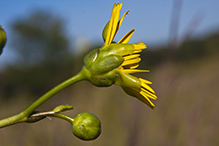 |
|||||
Basal Leaves |
|||||
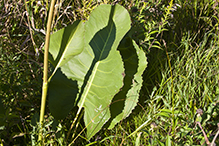 |
|||||
Stem Leaves |
|||||
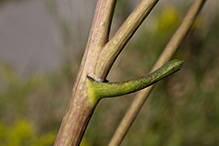 |
|||||
Stem |
|||||
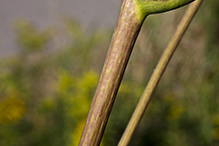 |
|||||

Visitor Videos |
|||
Share your video of this plant. |
|||
| This button not working for you? Simply email us at info@MinnesotaSeasons.com. Attach a video, a YouTube link, or a cloud storage link. |
|||
Other Videos |
|||
| MOCCASIN TELEGRAPH YEAR OH THE PRAIRIE DOCK Larry Henry |
|||
About
Published on Aug 19, 2013 RAIN, much more than normal in the last four years, has created ideal growing conditions for most Prairie Species.. The best Prairies in Ohio are in Adams County, South Central part of the state. The flower stalks are over 7ft. tall in some locations. |
|||


|
Created: Last Updated: © MinnesotaSeasons.com. All rights reserved. |
